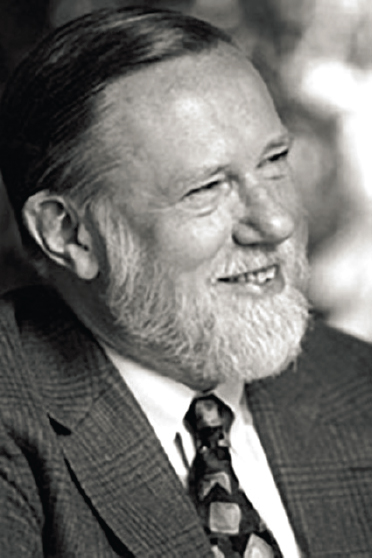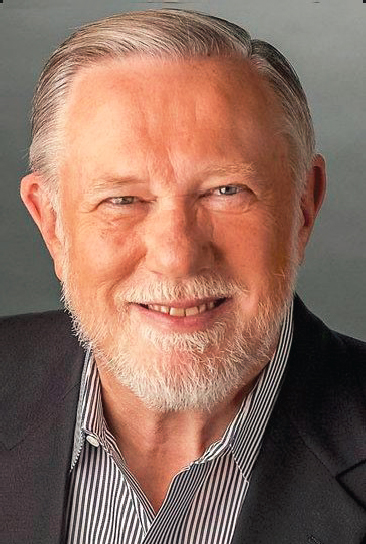CHARLES M. GESCHKE
1939–2021
Elected in 1995
“For contributions to the development of desk-top publishing.”
BY JOHN E. WARNOCK
CHARLES MATTHEW GESCHKE was born in Cleveland, Ohio, on September 11, 1939, to Matthew William and Sophia Krisch Geschke. He attended Saint Ignatius High School and then Xavier University, where he earned an AB in classics (1962) and an MS in mathematics (1963). He married Nancy (Nan) McDonough in 1964.
In his first job, he taught mathematics at John Carroll University (1963–68). In 1972 he completed his PhD studies in computer science at Carnegie Mellon University under William A. Wulf (NAE 1993). He was a coauthor of Wulf’s 1975 book The Design of an Optimizing Compiler (published by American Elsevier).
Chuck began his career at Xerox’s Palo Alto Research Center (PARC) in October 1972. His focus was on programming languages and tools used for the Alto workstations that were designed at PARC and used by all the center’s computer researchers.
In 1978 he formed the Imaging Sciences Laboratory, which focused on research in graphics, optics, and image processing. I was hired at PARC that year, and Chuck worked with me and other PARC researchers on Interpress, a printing protocol intended for Xerox laser printers. Unable to convince the company’s management to adopt Interpress as the Xerox standard,
we became frustrated and left to start Adobe Systems Inc. in December 1982. Adobe went public in 1986.
At Adobe, Chuck and I wanted to build a company with an open environment where all employees would like their jobs. As he said in a 2008 interview, “When we began, John and I wanted to build a company that we would like to work in. Why would you build a business you didn’t want to work in?”
Chuck was a great manager and together we hired the smartest people we could find. He served as Adobe’s chief operating officer (1986–94), president (1989–2000), and cochair of the board (1997–2017). He retired from the board of directors in 2019.
In 1982–87 Xerographic printers became popular as computer printers, and at Adobe we felt we could succeed with a very different appoach from the Xerox Interpress. We developed PostScript, a protocol (programming language) designed to express the contents of a printed page. PostScript became the industry standard worldwide in the years that followed.
Adobe’s success was broadly recognized by the industry and institutions, as were Chuck’s contributions. He received numerous awards and honors, among them the Association of Computing Machinery (ACM) Software System Award (1989), American Electronics Association Medal of Honor (2006), Marconi Prize (2010), and William K. Bowes Lifetime Achievement Award from the Commonwealth Club of California (2016). In 2009 Chuck and I received from President Barack Obama the National Medal of Technology and Innovation, “for their pioneering technological contributions that were central to spurring the desktop publishing revolution and for their role in changing the way people create and engage with information and entertainment across multiple mediums including print, video, and the Web.”
In addition to his election to the NAE in 1995, Chuck was recognized as an Ernst & Young Entrepreneur of the Year (1991, 2003), ACM fellow (1999), honorary member of the Institute of Electrical and Electronics Engineers (2001), and fellow of the Computer History Museum (2002), American Academy of Arts and Science (2008), and American Philosophical Society (2012).
He received honorary doctorates from Xavier University and John Carroll University, both in 2012.
Chuck recognized that the internet was not an unalloyed good. In 2013 remarks for the Markkula Center for Applied Ethics, he observed—somewhat presciently—that “Today on the internet…anybody can distribute content in a way that appears to be factual and accurate but is not…. [W]e’re apt to find ourselves reacting to information that is totally inaccurate and making decisions that could impact both our personal lives, our family’s lives, and in fact the life of the country in terms of political campaigning.” 1
Over and above his professional pursuits, Chuck served on the computer science advisory board at Carnegie Mellon University and the board of the San Francisco Symphony, National Leadership Roundtable on Church Management, Commonwealth Club of California, Tableau Software, Egan Foundation, and Nantucket Boys and Girls Club. In service to the National Academies, he was a member of the Government-University-Industry Research Roundtable (1997–2000), National Forum on Science and Technology Goals: Harnessing Technology for America’s Economic Future (1997–99), and Computer Science and Telecommunications Board (1993–96).
Chuck had an unusually traumatic experience in 1992. On the morning of May 26, as he was arriving for work, he was kidnapped at gunpoint from the Adobe parking lot by two men. The FBI monitored the kidnappers’ phone calls to Chuck’s wife, and one of the men was arrested after he picked up the $650,000 ransom that Chuck’s daughter left at a drop-off point. The man brought the authorities to a bungalow in Hollister (about 60 miles south of the Adobe office in Mountain View) and Chuck was, fortunately, released unharmed.
Charles Geschke died April 16, 2021, at the age of 81. He is survived by his wife Nan; their children Peter, John, and Kathy; and seven grandchildren.
Chuck is greatly missed.
__________________
1 Available at https://www.youtube.com/watch?v=ySZT8gtPXcw&t=2s.






